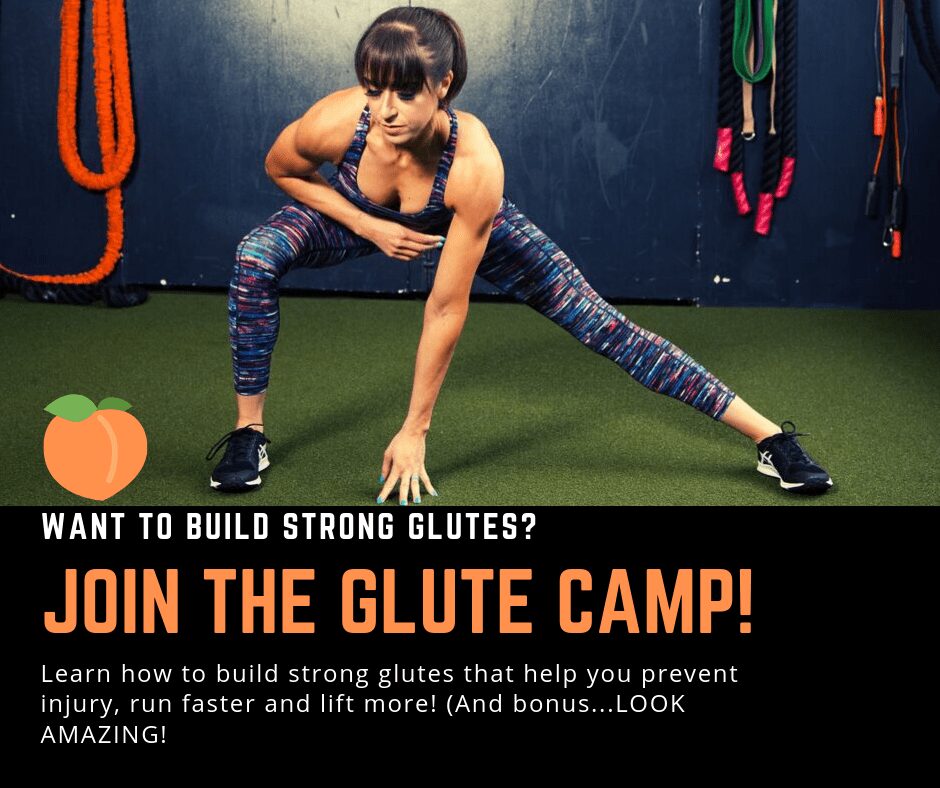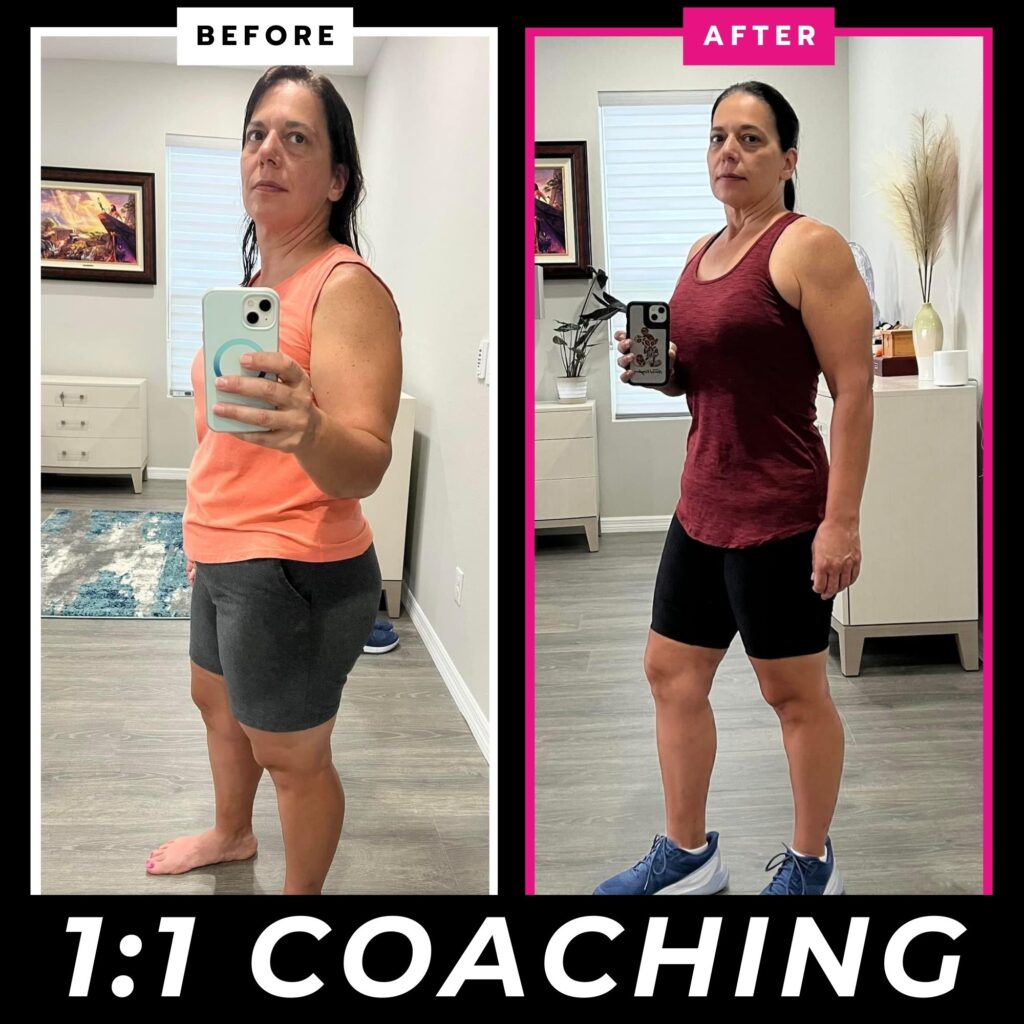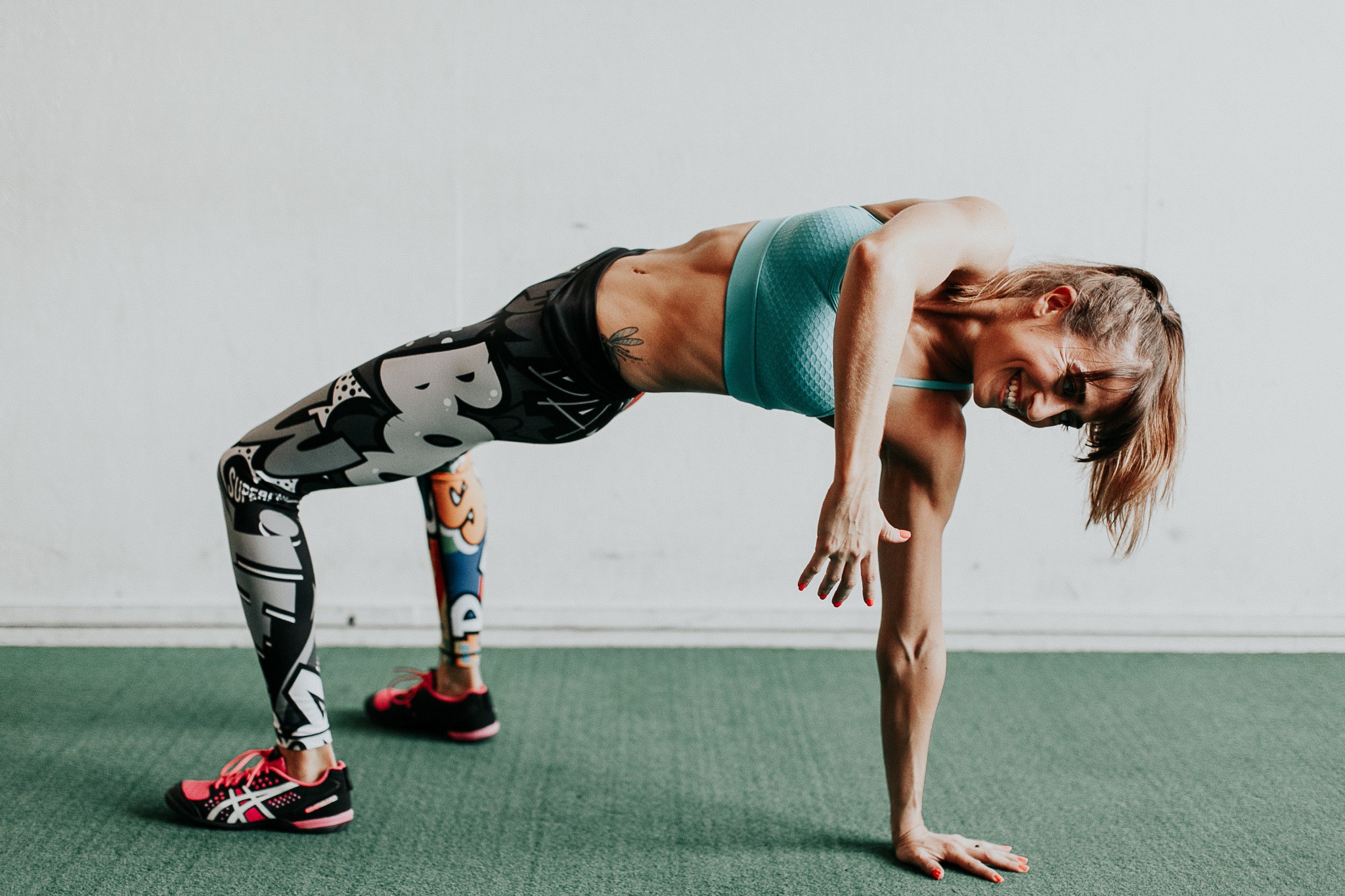
The Bridge Booty Burner
Bridges are a MUST-DO….I mean MUST-DO glute activation move.
They help you improve your hip extension to unlock tight hips as they activate. And all you need is your own bodyweight to start feeling those glute works.
Plus glute bridges are even a great move to start working your abs. By engaging your abs with a posterior pelvic tilt, not only can you activate those core intrinsic stabilizers, but you can actually help get a better glute contraction!
So if you’re ready to loosen up tight hips and activate your glutes, try this Bridge Booty Burner from my 28-Day Booty Burner Series! (BONUS: Some of these bridges will also open up your chest and shoulders to reverse that hunched posture we spend way too much time in during the day!)
Bridge Booty Burner
Complete 2-4 rounds of the burner below. If you are using it as a warm up, even just 1-2 rounds is all you need! Rest up to 45 seconds between rounds if needed. Make sure your glutes are working. If your low back or hamstrings start to take over, pause or rest to make sure your glutes keep doing the work!
CIRCUIT:
5 reps per side Sit Thru to Thoracic Bridge
10 reps Camel Bridge
15 reps Tabletop Bridge
20 reps Glute Bridge
5 Signs That Your Hips Are Locked Up And Glutes Are Inactive…
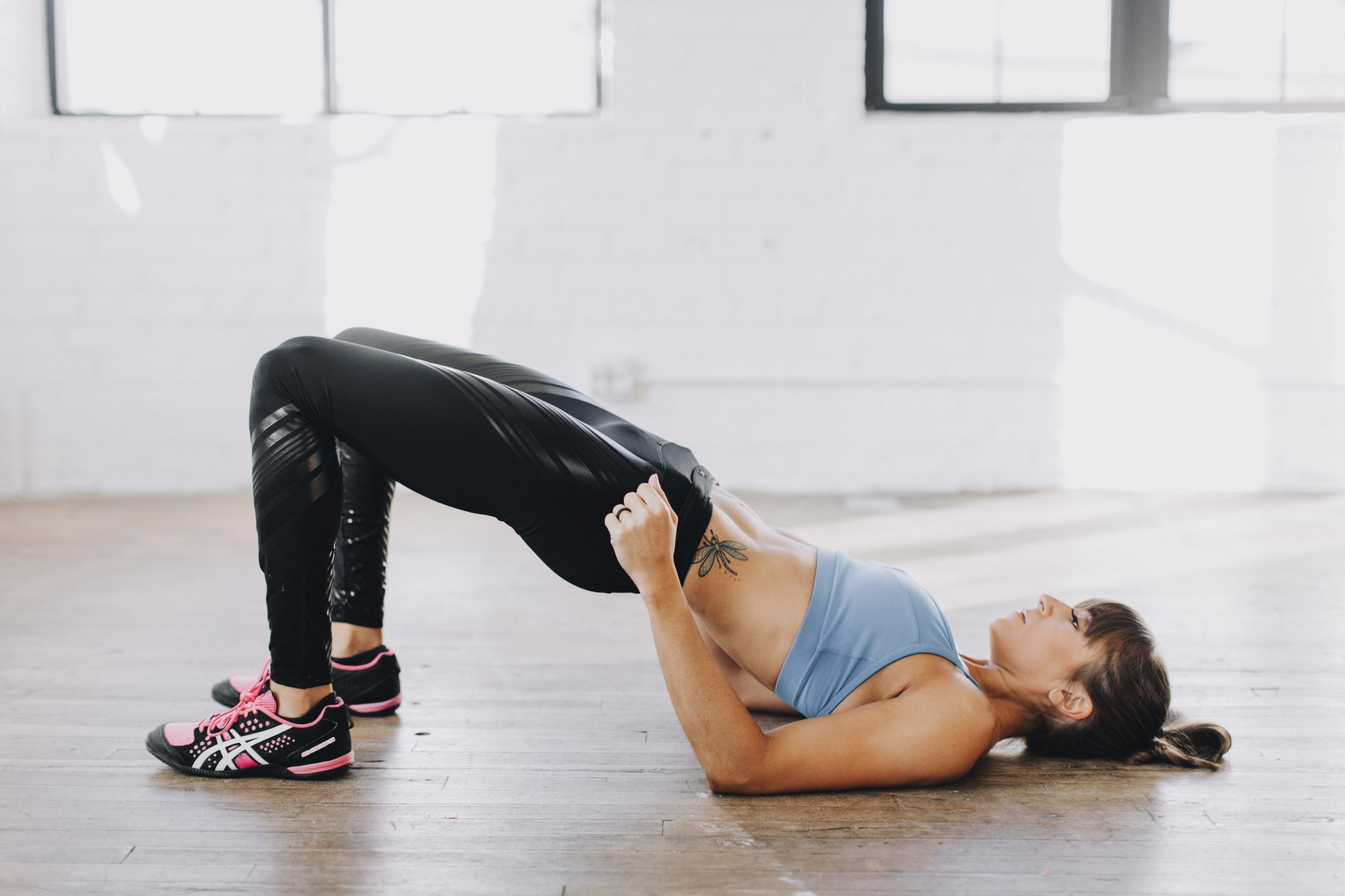
Are You Bridging Wrong?
Glute bridges are a basic bodyweight move.
People will even say, “These are easy!” And think they are beyond that basic bodyweight exercise.
But guess what!?
All too often people aren’t doing them correctly! AND even the most advanced exerciser needs to return to that FUNDAMENTAL move.
Let me ask you a few quick questions too…
- Have ever felt your low back during glute bridges?
- Or maybe your hamstrings are doing all the work?
- Or maybe your quads are working?
- Heck…maybe you even feel your traps and shoulders!
Answer yes to one of these?…Or maybe all of these, huh?
Well it’s called the GLUTE BRIDGE for a reason…Not because these other muscles should be working, but because your GLUTES should be powering the move.
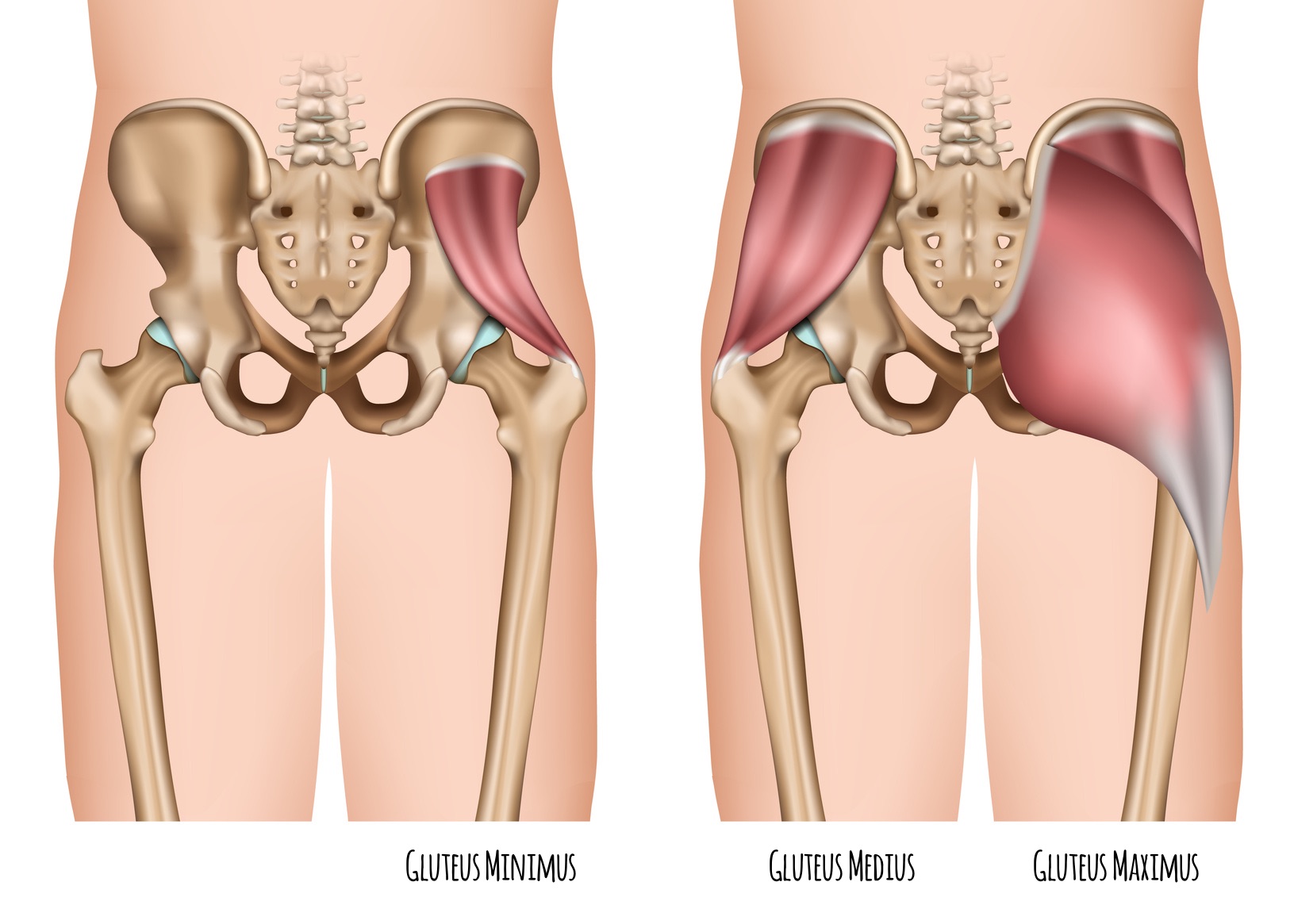 So if you’re feeling these other muscles engaging and taking over for your glutes, you not only aren’t reaping the benefits of the glute bridge, so may need to change your form, but you’ve also got some compensations you may need to address that could lead to injury!
So if you’re feeling these other muscles engaging and taking over for your glutes, you not only aren’t reaping the benefits of the glute bridge, so may need to change your form, but you’ve also got some compensations you may need to address that could lead to injury!
And if you’re now thinking…”Well I just really don’t feel anything. And I don’t feel my glutes at all so I probably just need to do something HARDER…”
You’re also wrong.
Yes, as we advance, we want to add weights and harder variations to keep challenging our muscles so we get results.
BUT…No matter how advanced you are, heck actually even the MORE advanced an exerciser you are, the MORE you should be able to contract your glutes during a basic bodyweight bridge.
Now note I didn’t say it should necessarily be “hard” to do as an advanced exerciser, but you should be able to contract your glutes to create a burn even with just your own bodyweight no matter how much you lift.
Because it all comes down to the mind-body connection.
If you can’t recruit the muscles correctly with your own bodyweight, there is a good chance you won’t recruit the right muscles as you add more and more load or try harder and harder variations.
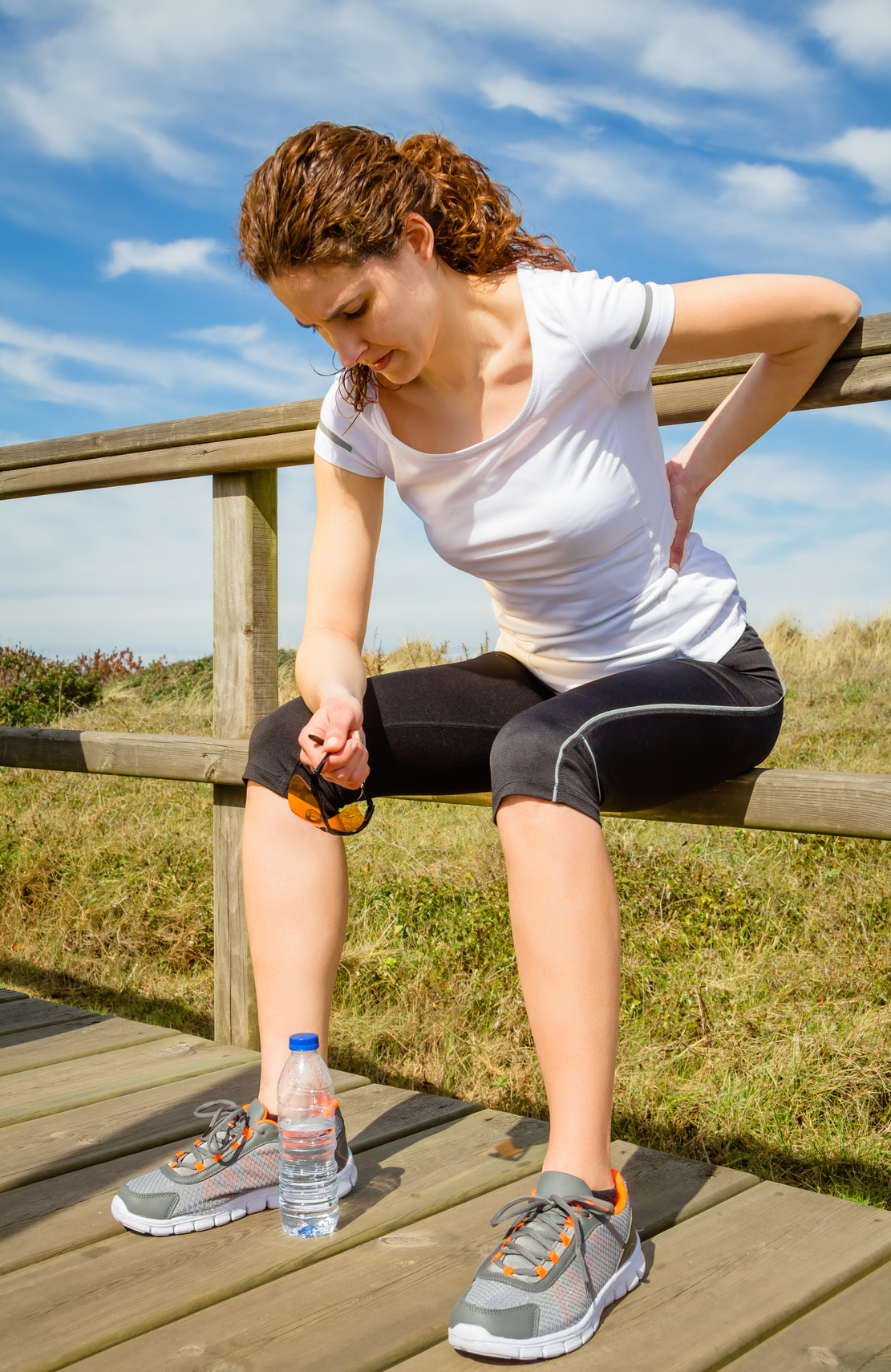
And if you aren’t using the right muscles?
Well that is when you risk overloading muscles that can’t handle the load, which can lead to INJURY.
That is why I wanted to share a few quick tips and coaching cues hat I use with my clients so they can get those glutes activated and firing.
Because the basic glute bridge is a must-do activation move. It can help activate the glutes and improve your hip extension so you can run faster and lift more.
BUT it must be done correctly so your glutes actually engage!
So if you’re not feeling those glutes working, try these 4 tips to improve your bridging.
Bridging Tip #1: Mind Your Set Up!
Many people when they go to bridge up just lie on their back and lift their butt off the ground. They pay no attention to foot positioning or what muscles they are using to drive up.
But by paying attention to how you are driving up and the positioning of your feet, you can make sure your glutes are working and other muscles, like your hamstrings, aren’t compensating.
 A great way to start to set up is to lie on your back and place your feet flat on the ground just beyond your fingertips when your arms are straight down by your sides. If your feet get too far away from your butt, you are more likely to use your hamstrings.
A great way to start to set up is to lie on your back and place your feet flat on the ground just beyond your fingertips when your arms are straight down by your sides. If your feet get too far away from your butt, you are more likely to use your hamstrings.
You also want to make sure your feet are flat on the ground. You’ll sometimes see images of people up on their toes during bridges, but talk about a way to make it more challenging to engage your glutes. Actually, if you struggle to engage your glutes, think about driving more through your HEELS as you bridge up.
Then, once you have this positioning, bend your elbows and drive them into the ground. You want to think about driving your elbows down into the ground and then even drive through your upper back as you bridge up. This will help prevent you from feeling bridges in your upper traps and neck. It can also help you make sure your glutes are working and you aren’t again making your hamstrings the prime movers.
And then when you bridge up, driving your heels and upper back into the ground, think about driving your knees forward over your toes.
Don’t lift your heels to try and do this. Or adjust your feet in closer (adjusting your feet in closer may actually make you start to feel the bridge in your quads if your hips are tight). Your knees will not actually go over your toes!
The point is by thinking about driving your knees toward your toes, you won’t drive yourself backward onto your shoulders. You will also make sure to evenly drive through your upper back. This will help focus on the glutes and make sure your hamstrings and traps don’t get overloaded.
Then make sure your feet are even and about hip-width apart. You don’t want your knees falling open or caving in. You CAN do a close-stance glute bridge or a wide-stance glute bridge but you need to still make sure your ankles, knees and hips are in the proper alignment. If they aren’t in alignment, you are going to perpetuate poor movement patterns.
This proper set up can also help you unlock tight hips by forcing your glutes to create hip extension as you bridge up. It will also prevent your quads from taking over, which if they do start trying to work, won’t help you open up tight hip flexors.
Part of this set up also needs to be learning to engage your abs, which can be done using a posterior pelvic tilt!
Bridging Tip #2: Tilt It Up Aka Stop Trying To Use Your Back To Get Up Higher!
One of the things that happens most often is that, in an attempt to bridge up HIGHER, people arch and use their lower back. And then they just push and ignore the fact that all they feel is their lower back.
Why does this happen? Why aren’t your glutes firing like they should be and you are instead loading your low back?
Because when we are focused on simply bridging up higher to replicate a movement, instead of focusing more on the muscles that should be working, our bodies recruit whatever muscles are easily available to meet our demands.
We will demand mobility out of an area that really shouldn’t be providing that mobility. And we will overuse muscles that aren’t meant to handle the load. Because our body takes the path of least resistance to do the movements that we ask of it.
And this process of compensation often happens because our hips are tight and our glutes, and even our abs, are underactive.
That is why it is key to do bridges correctly so you can improve your hip extension AND activate your glutes and abs. And the key to doing this is the posterior pelvic tilt!
By using the posterior pelvic tilt, you can engage your abs, prevent hyperextension of your lumbar spine AND get your glutes to power the bridge and hip extension.
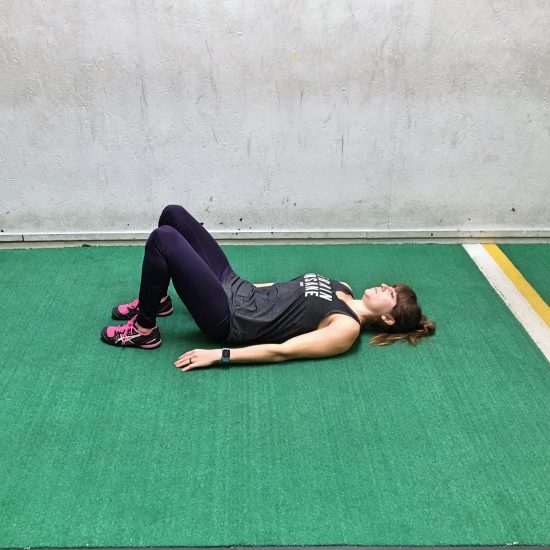 To do the posterior pelvic tilt, set up at the bottom of the bridge with your feet flat on the ground and elbows driving down into the ground too.
To do the posterior pelvic tilt, set up at the bottom of the bridge with your feet flat on the ground and elbows driving down into the ground too.
Feel the space between your low back and the ground? Push that space away so you are tilting your hips and pressing your low back into the ground.
You may feel too like you are drawing your abs in toward your spine.
Keeping the core engaged like this, bridge up. Squeeze your butt and pause. Do not worry about how high you go. Just squeeze the butt as you keep your abs engaged in this way. Then lower down.
You may notice at the top you start to lose the tilt as you just try to drive up higher. This means you are trying to again arch your lower back instead of just extending your hips.
It is key with all of these tips, and with all exercises for that matter, that not only do you pay attention to form, BUT you THINK about the muscles that are working so you can realize if you lose the posterior pelvic tilt and stop using your glutes.
Lower back down and repeat. If you need, reset that posterior pelvic tilt each time. But focus on maintaining that so you CAN’T arch your low back and can only bridge as high as you glutes, and hips for that matter, allow!
Bridging Tip #3: THINK About The Muscles That Should Be Working
As I mentioned above, you have to THINK about the muscles working. Part of contracting your muscles and feeling them work is about establishing the mind-body connection so your mind can more efficiently and effectively recruit the right muscles for the job.
And basic bodyweight activation moves like the bridge are the easiest way to improve your mind-body connection so things work correctly during more compound lifts.
Think about how many times you’ve just gone through the motions of a workout? Or pushed through even when you sort of know the wrong muscle, aka your low back, is working.
You just figure, “Hey gotta get through the workout!”
The problem is…That attitude can lead to injury. AND it can also mean that all these workouts you’re spending “working your glutes” are actually going to waste.
Cause guess what!?!
Your glutes aren’t working!
So during these moves THINK about your glutes driving the movement. That way you can adjust if they aren’t. And by focusing on your glutes working, you can contract them even harder as you pause at the top of the bridge.
Heck…it can even be fun to see how much shakeage you can create by mentally trying to contract harder!
Bridging Tip #4: What If I STILL Don’t Feel My Glutes?!
There is a chance that you will still struggle, even after trying to tweak your form, with activating your glutes. Heck maybe even just one side doesn’t seem to want to engage!
This is where some mobility work, some Foam Rolling and Dynamic Stretching may need to come into play first to loosen those tight muscles so your glutes can engage properly.
Using rolling first can help you relax tight and overexcited muscles, muscles your mind may want to usually recruit first.
Roll your hamstrings (often for people rolling right under the glute helps).
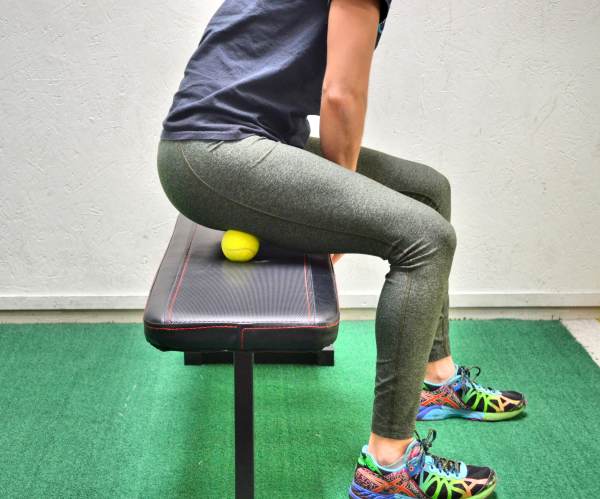
Roll your hips to help loosen tight hips before you bridge. Heck, roll your quads!
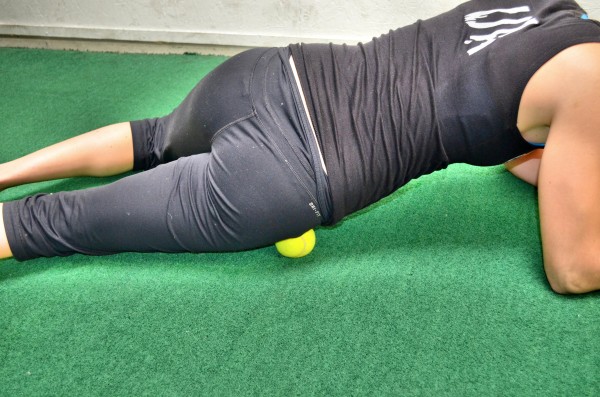
Start there. Then do even a dynamic stretch or two, like the Half-Kneeling Hip And Quad Stretch, to start to open up your hips.

THEN try the glute bridge.
Often rolling, stretching THEN activating can help us FEEL the glutes working when they should be!
That process will allow us to restore muscles to their proper length tension relationships so we can get the right muscles working…AKA our GLUTES!
But what if it is only one side?
Well the focus on that tight side and even try some unilateral activation before.
Try a Fire Hydrant or Donkey Kick. Another basic bodyweight moves to focus on that side that isn’t firing.
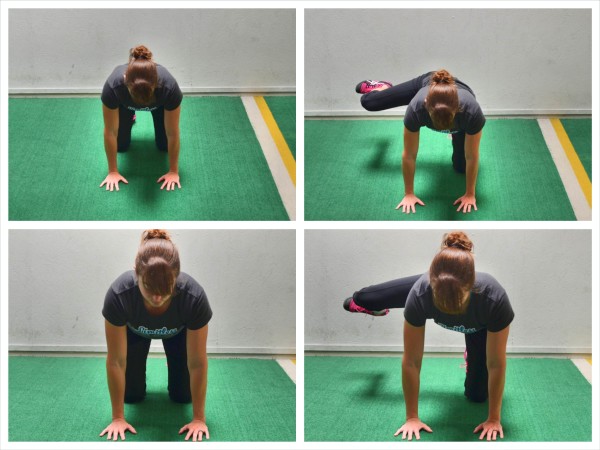 THEN return to the bilateral move once you’ve established the mind-body connection! (I mention the Fire Hydrant too because sometimes activating the glute medius helps the glute maximus fire better even during moves like the Glute Bridge!)
THEN return to the bilateral move once you’ve established the mind-body connection! (I mention the Fire Hydrant too because sometimes activating the glute medius helps the glute maximus fire better even during moves like the Glute Bridge!)
But NEVER underestimate the importance of the Basic Bodyweight Glute Bridge. And don’t ignore the importance of those other silly looking basic activation moves for your glutes either!
Those moves are what help you prevent injury and get the right muscles working.
These silly, BASIC moves are so important it’s why I created a 28-Day Booty Burner to help my clients get their glutes working the way they should be!
Learn More About Glute Activation And Unlocking Tight Hips –>

This Important Glute Muscle – The Gluteus Medius
This Important Glute Muscle – The Gluteus Medius You know those silly looking lying leg raises Jane Fonda used to do? Or those Fire Hydrant quadruped leg lifts that feel so silly…like you’re a dog taking a pee? Those moves…well those...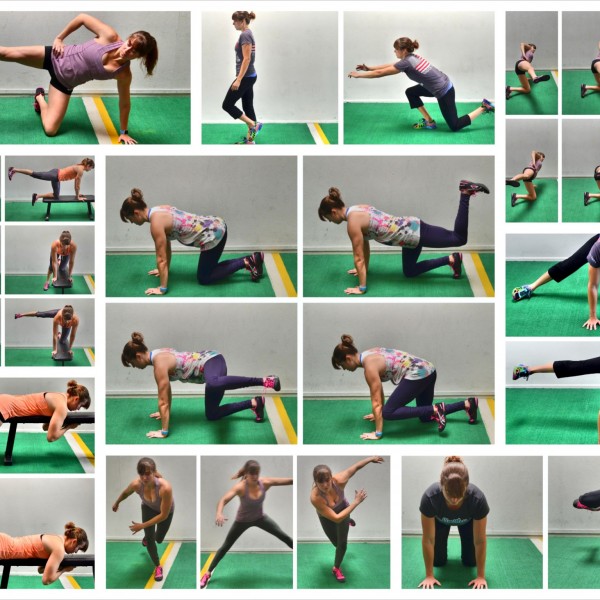
Target Those Glutes – 15 Bodyweight Glute Exercises
All over the internet Squats are promoted as a great booty building exercise. You see “She Squats” or “I Squat” or simply booty shorts with “Squat” everywhere.
But Squats aren’t the best or only glute exercise out there that you should be doing. (Actually the statement “Squat to build a better butt” is one of the 2 Popular Glute Myths That Are Holding You Back…Learn More!)
Actually many of the best glute building exercises out there can easily be done at home and require only your own bodyweight.
Many of these bodyweight moves are so effective because many of them are isolated, focused glute movements.
While we often focus on compound movements because they give us more bang for our buck and work multiple muscle groups at once, they aren’t always the best glute exercises because our glutes can struggle to actually engage during these movements.
And if our glutes don’t engage properly, not only are they not actually getting worked, but we also risk injury and overworking other muscles.
So if you sit all day, whether it’s driving, flying or simply sitting at a desk, your glutes are probably underactive and you need to include some isolated, focused glute exercises to get them activated and working.
You need to include most of these bodyweight exercises just so you can get your glutes to actually engage and work during compound heavy lifts like Squats or Deadlifts.
These Bodyweight Glute Exercises will activate and strengthen your glutes so that you not only have stronger, sexier glutes, but can also lift more. Plus, a few of the plyometric moves at the end will also help you develop great glute power, which is also important if you want to run faster!
15 Bodyweight Glute Exercises
The glutes are probably the most commonly underactive muscle group. And they are also probably one of the most important muscle groups to have be engaged and working.
Getting your glutes activated and strong can help you lift more, run faster, look better and prevent injury. Getting your glutes activated can help you prevent low back, hip and knee pain, especially if you’ve suffered from injuries in the past.
Getting your glutes activated will also help you have a stronger core.
Your glutes are an important part of your core that need to be activated so you will be functional stronger, not only for everyday life, but also for almost every sport out there.
So start getting your glutes activated and strong with these 15 moves.
Fire Hydrants – If you want truly strong glutes, you need to work them from every angle. Plus frontal plane, lateral movements like the Fire Hydrant are a great way to strengthen your glute medius and minimus.
Strengthening these two glute muscles will build your hip stability to prevent injury and make your glutes stronger so that you can lift more and move more powerfully during sports and other activities.
There are two variations of the Fire Hydrant that you can include in your workouts – the Bent-Knee and the Straight-Leg Fire Hydrants. Beginners will want to start with the Bent-Knee Variation and only progress to the Straight-Leg Variation as their glutes become stronger.

Bent-Knee Fire Hydrants – To do Bent-Knee Fire Hydrants, start on your hands and knees with your hands under your shoulders and your knees under your hips. Flex your feet. Keeping your arms straight and your feet flexed, raise your right leg out to the side with the knee bent to 90 degrees.
As you raise your leg out to the side, you want to keep your ankle in line with your knee and not let your foot get above your knee or your knee go up above your foot. You want to try to raise your lower leg parallel to the ground when you lift your leg out to the side.
You should feel the outside of your hip and glute working to lift the leg to the side. Don’t simply lean away to get your leg up higher. Keep your core tight and lift from the hip using your glute. Hold at the top then lower back down.
Make sure to hold for 1-2 seconds. Do not rush through the lift or simply swing the leg up. Make sure you do not bend your arms to get your leg up higher. Squeeze your butt and make sure you feel it activate.
Range of motion isn’t important as long as you feel your glute working. You may even feel this in the leg you are kneeling on because your glute is working to stabilize. Complete all reps on one side before switching.
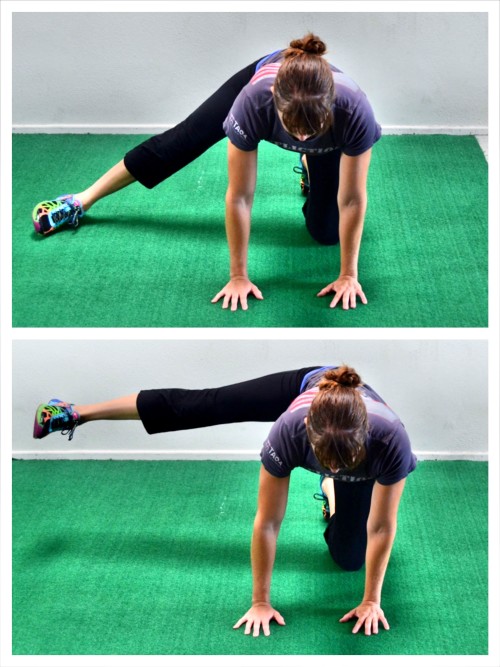
Straight-Leg Fire Hydrant – To do the Straight-Leg Fire Hydrant, start quadruped on the ground with your hands under your shoulders, your knees under your hips and your feet flexed. Unlike with the Bent-Knee Hydrant, with the Straight-Leg Variation, you will straighten your leg out to the side in line with your hip before lifting.
Keeping your arms straight, lift your straight left leg up toward the ceiling. Do not bend the knee. Squeeze your glute as you lift and make sure to keep your arms straight. Do not bend your arms and lean away just to get your leg higher up.
Hold for a second or two at the top then lower back down. Tap your foot down and repeat. Make sure that you lift straight out to the side and keep your leg straight. You want to make sure you are lifting basically straight up to the side. Complete all reps on one side before switching.
Side Plank Clams and Side Plank Leg Raises – If you want to work your obliques while you work your glutes, then you need to do Side Plank Clams and Side Plank Leg Raises. And like the Fire Hydrants, these moves will strengthen your glute medius and minimus.
These both are great moves to work the sides of your entire core and build hip stability.
And even though the Side Plank Clams are from your knees, they are not simply an easier variation of the Side Plank Leg Raises. The Side Plank Clams are a slightly different movement with a hip dip and leg raise to really work your sides while the Side Plank Leg Raises are an isometric hold with a top leg lift.
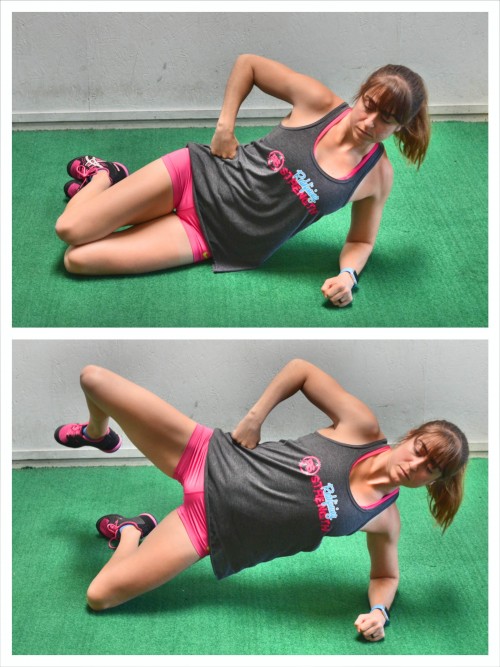
Side Plank Clams – To do the Side Plank Clam, set up on your side propped up on your forearm with your elbow underneath your shoulder. Bend your knees so that your feet and lower legs are behind you. You can place your top hand on your hip or reach it up toward the ceiling, but don’t touch it down to the ground or use it to help you balance or press up.
Propped up on your elbow with your knees stacked, lift your bottom hip up off the ground, driving through your knee and forearm. As you bridge your hips up, lift your top leg up and toward the ceiling, keeping the knee bent. Open up your legs, lifting your top leg up as high as you can then lower the leg back down.
When you lift, don’t rotate open. Lift your leg straight up to the side. As you lower the leg back down, lower your hip back down to the ground.
Repeat, bridging up as you raise your top leg up toward the ceiling. Complete all reps on one side before switching. Make sure you are lifting your top leg straight up and not rotating toward the ground or open toward the ceiling.
Don’t rotate your knee up and open. Lift the entire top leg up. Also keep your elbow under your shoulder and do not get too spread out. Really focus on bridging and lifting with your glute and obliques.

Side Plank Leg Raises -To do the Basic Side Plank Leg Raises set up in a Side Plank from your forearm. Lie on your side and prop yourself up on your forearm with your elbow right below your shoulder. Your legs should be out straight and your feet should be stacked.
Then, driving through your forearm and the sides of your feet, lift your bottom hip up off the ground as high as possible while keeping your body in a nice straight line. Squeeze your belly button in toward your spine and keep your glutes tight. Do not let your chest rotate forward toward the ground or your top hand touch the ground. Keep your top hand on your hip or reach it up toward the ceiling.
Then, holding the Side Plank, lift and lower your top leg up and down. Do not let your hips drop toward the ground as you lift the leg. Beginners may need to do the Side Plank Leg Raises from a Side Plank on their knees.
Straight Leg Kickbacks – This is a great move to activate the glute maximus while engaging your core. It is also a unilateral move so it forces each side to work independently so that your dominant side can’t take over and compensate.
The Straight Leg Kickbacks are also a great hip extension exercise to do after sitting at a desk all day. Just make sure you focus on kicking back and not simply trying to raise your leg up toward the ceiling or you won’t extend your hip and activate your glute.
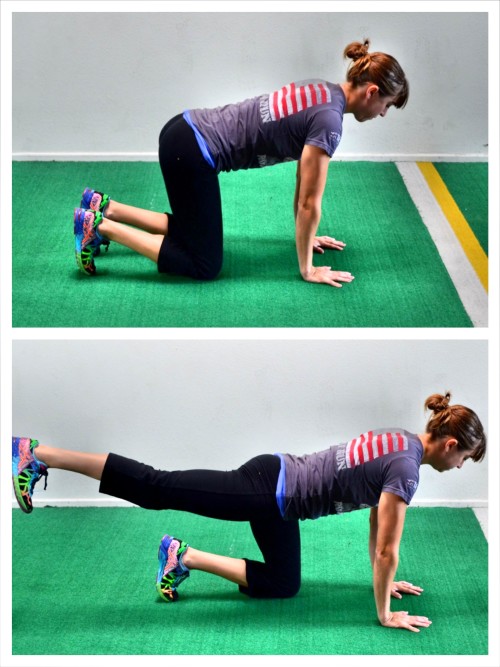
To do the Straight Leg Kickback, set up on your hands and knees with your hands under your shoulders and your knees under your hips. Flex your feet.
Then keeping your arms straight and abs braced, kick one leg back, driving your heel straight back into the wall behind you. Squeeze your glutes as you lift the leg and drive the heel toward the wall behind you.
Don’t let your hips rotate open as you kick back. Keep them square to the ground. Also don’t arch your low back just to try to kick your leg back and up higher. Really focus on driving your heel back toward the wall behind you.
The height of the kickback doesn’t matter as long as you feel your hips extend and your glutes engage. You do not want to feel this move in your low back.
Hold for a second or two at the top and really contract your glutes before lowering back down. Don’t rush the movement.
Complete all reps on one side before switching.
Frog Bridges – If you really struggle to get your glutes activated and working, this is a must-do move for you. Because of the positioning of your body, this moves makes it easier for people to really isolate their glute.
That means the Frog Bridge is both a great activation move AND a great move to use at the end of your workout to burn out those butt cheeks!

To do the Frog Bridge, lie back on the ground and place the bottom of your feet together, letting your knees fall open sort of as if doing the butterfly stretch. The closer you bring your feet in toward your crotch, the more mobility you need to do the move. Find a comfortable placement and allow your knees to relax open.
Lying on your back with your knees wide and the bottoms of your feet together, bend your elbows to 90 degrees so that only your upper arms are against the ground. You want to really drive your elbows down into the ground as you bridge up.
Driving through your upper arms and the outsides of your feet as you engage your core, bridge up while keeping your knees open. Squeeze your glutes as you lift and really contract them at the top.
Then lower back down and repeat.
Keep your core engaged and really drive down through your upper arms so that you don’t push yourself backward as you bridge back up. Do not let your knees come back together. Keep them relaxed and open.
Concentrate on your glutes working to lift. Make sure to pause and engage your glutes at the top.
If you feel your hips too much, don’t bring your heels in as close to your body.
Glute Bridges – It’s a basic move, but a must-do one. Whether you are doing Glute Bridges off the ground, with your feet raised, as a single leg move or even with holds or slow tempos, you need to do this move.
Glute Bridges activate your glutes while extending your hips, which makes them especially important for anyone that sits all day because they are the opposite of what you do all day at your desk.
Whether you want to avoid hip and low back pain, lift more or run faster, you need to include Glute Bridges.

To do the Basic Glute Bridge for reps, bend your knees and put your feet flat on the ground just close enough that you can graze your heels with your fingertips when you stretch your arms down by your side. You can play around with the exact positioning of your feet. If your hips are tight, you may need to put your heels further away from your fingertips to make sure your glutes engage and work instead of your hamstrings. Do not let your hamstrings take over. Your feet should be about hip-width apart as well.
Bend your elbows to 90 degrees so that only your upper arms are on the ground. This will allow you to drive through your upper arms and back as you bridge up.
Then drive up through your heels and upper back to lift your glutes up off the ground. Drive your hips up as high as possible, squeezing your glutes hard. Keep your belly button drawn in so you don’t hyperextend your back. Focus and consciously squeeze your glutes at the top.
As you bridge up, do not push backward off your heels. Make sure you are driving straight up and that your knees aren’t caving in. You may even want to think about driving your knees forward over your toes as you bridge up.
Squeeze your glutes for second or two at the top and lower all the way back down to the ground before repeating.
Do not rush through the move. To make the move harder, hold longer at the top or even slow down the lower back down to the ground. A slower tempo means more time under tension and more work for your glutes.
You can also make this move more challenging by doing a Single Leg Glute Bridge or by placing your feet up on a box.
For more Glute Bridge Variations, click here.
Hip Thrusters – The Hip Thruster is a more advanced Glute Bridge Variation and a great way to really strengthen your glutes.
If you struggle to get your glutes firing during the Basic Glute Bridge, don’t attempt the Hip Thruster. It is very easy to feel your legs and even your low back taking over for your glutes if you aren’t careful and your glutes aren’t activated and working during the Hip Thruster.
And while the Hip Thruster will work your entire leg, unlike the Glute Bridge which is more isolated, it should still be a glute driven movement.
The Hip Thruster can be done as a bilateral or a unilateral movement. You can also do it with only your back raised on a bench or with both your feet and back up.
Having both your feet and back up is a great way to really build glute strength. Below are both a Bilateral and a Unilateral Hip Thruster Variation with Feet Raised.

Bilateral Hip Thruster With Feet Raised – To do the Bilateral Hip Thruster with Feet-Raised, place a box and a bench close enough together that your back can be on the bench and your feet up on the box with your knees bent to about 90 degrees. You may not be right at 90, especially if your hips are tighter, You just don’t want your legs to be out too far. If your legs are out too straight, you will use more hamstrings than glutes.
Then with your feet and back both up on boxes or benches, bridge up, driving up through your heels and your upper back. Press your hips up and squeeze your glutes. Lift your hips to full extension and hold for a second and then lower back down. Make sure you don’t drive yourself backward over the bench. You want to bridge straight up and feel like you are driving your knees forward over your toes.
Make sure you don’t hyperextend your low back at the top, but instead brace your abs and consciously squeeze your glutes. You may even want to perform a pelvic tilt as you perform Hip Thrusters so that you don’t hyperextend your low back if you are prone to do so. Make sure your knees don’t fall apart at the top but stay in line with your hips and ankles.
When you drop back down, make sure to drop your butt below the height of the box and repeat. You do not have to touch the ground each time, but you do want to do a bigger range of motion than you could if performing a bridge from the ground.
If you can’t lower down past the box, you may want to regress the move to a Glute Bridge Off Box or even a Hip Thruster with only your back on a bench.
Do not rush through this movement.
You can progress this movement by holding longer at the top and by slowing down the tempo of your reps. More time under tension makes the move more challenging and helps you strengthen your glutes. You can also do the Unilateral Variation to make it more challenging.
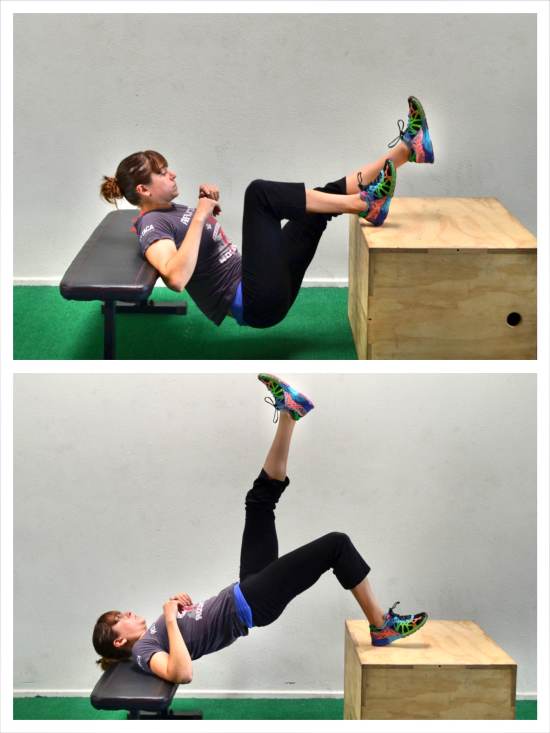
Unilateral Hip Thruster With Feet Raised – To do the Unilateral Hip Thruster With Feet Raised, set up with your heels on a box and your upper back on a bench just like with the bilateral movement. Then raise one foot up off the box. You can raise the foot straight up toward the ceiling or keep the raised leg bent.
Then, driving through the heel on the box and your upper back, bridge up. Lift your hips up as high as you can. As you bridge up, just make sure you aren’t swinging your raised leg to help you lift.
Squeeze your glutes and keep your core tight as you extend your hips so that you feel your glutes working and not your low back.
Pause at the top and then lower back down past the box and repeat. Complete all reps on one side before switching.
If you can’t fully extend your hips like you did with the Bilateral Variation (or you feel your low back taking over), you may not yet be ready for this variation. This movement is more difficult because one leg is doing all the lifting.
This move can also be made even harder by slowing down the tempo and even holding longer at the top.
3-Way Hip Circles – It is important that we strengthen our bodies in numerous planes of motion through a full range of motion. That is why 3-Way Hip Circles are such a great move to include.
The 3-Way Hip Circles open up your hips as they activate all three glute muscles. They even engage and work your core.
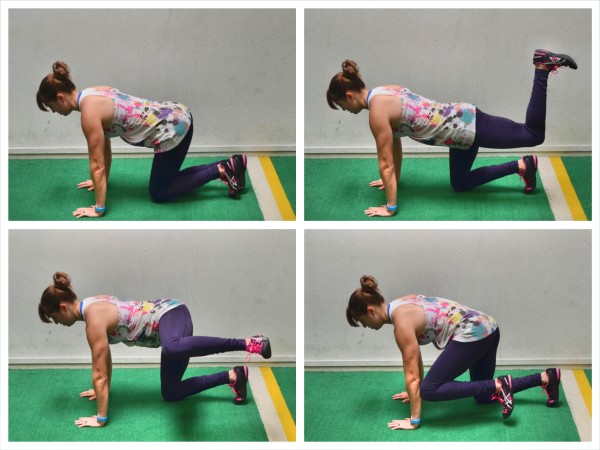
To do the 3-Way Hip Circles, start on your hands and knees with your knees under your hips and your hands about under your shoulders. Then flex your feet and brace your abs.
Keeping your arms straight and your knee bent to about 90 degrees, kick one leg back, driving the heel up toward the ceiling. Make sure to keep the knee bent as you drive the heel back and up. Also, squeeze your glute at the top and do not hyperextend your low back or rotate your hips open to try to get your leg up higher. Range of motion isn’t as important as getting your glute to engage. Extend your hip and squeeze your glute to kick back. Do not let your hamstring take over.
Hold there for a second. Make sure to keep your arms straight and concentrate on squeezing your glutes while keeping your abs engaged.
Then, without lowering the leg down, bring the leg up to the side into the Fire Hydrant position. Keep your foot flexed and knee bent to 90 degrees. Also make sure to keep your knee and ankle in line. Do not let your knee get up higher than your foot or your foot get up higher than your knee. When you raise your leg up to the side, you want your lower leg to be even, or as close as possible, parallel to the ground. Do not bend your arms or lean away as you raise the leg out to the side. Feel the outside of your hip work to lift.
Hold there for a second and feel your glute working to hold the leg up.
Without touching the knee down, drive the knee forward into your elbow. Feel your abs engage as you hold. Really feel your abs work to tuck the knee into your elbow. Do not tuck your chin as you pull the knee in. Also, do not simply go through the motions. Use your abs to pull it in and keep them engaged as you hold.
Hold there for a second then repeat on the same side starting with the kick back.
Side Balance Leg Lifts – If you think Fire Hydrants are challenging, then you are going to love Side Balance Leg Lifts. This move will really work the outside of your glutes as well as you core.
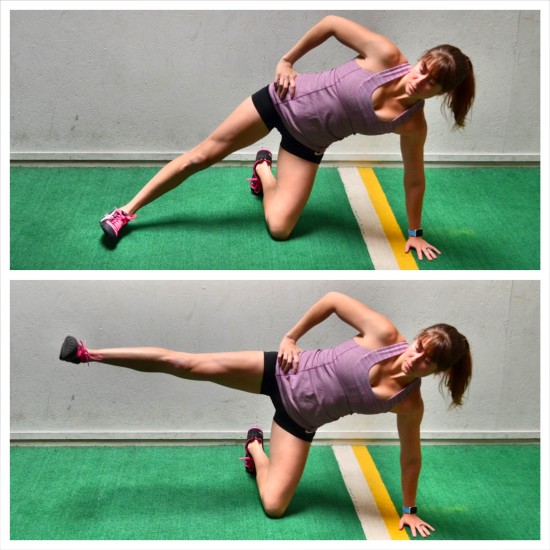
To do Side Balance Leg Lifts, start on one knee with your other leg out straight to the side. Then place your hand down on the outside of your knee so you are in a side balance position. Your hand should be under your shoulder while your knee will be just slightly below your hip.
Then lift your top straight leg up toward the ceiling. Lift the leg as close to parallel to the ground as you can and then lower back down. Do not swing your entire body to lift the leg. Keep your core tight and do not let your body rotate toward the ground or open toward the ceiling as you lift.
Feel the outside of your glute and hip working to lift the leg.
Complete all reps on one side before switching.
Side Balance Leg Circles – Not only do our joints respond well to circles, but our mind-body connection is improved when we can learn to isolate areas of our body and individually engaged them.
Side Balance Leg Circles open up your hips while engaging and working your glutes and core. Your core is forced to stabilize to keep you balanced as you circle from your hips, making your glutes work.
This is a very challenging move for your glutes and beginners may want to start with a quadruped variation instead of this Side Balance move.
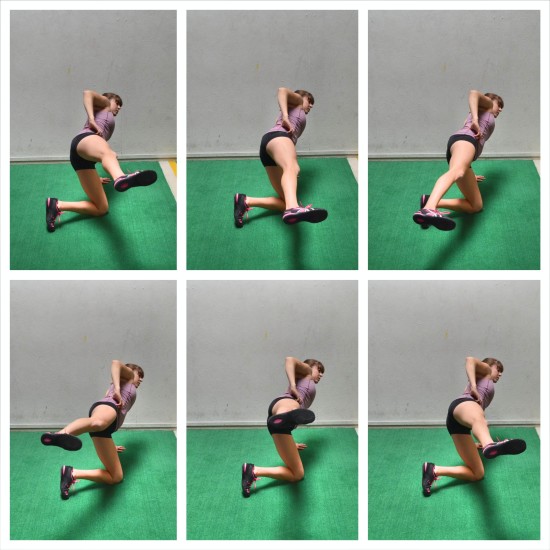
To do Side Balance Leg Circles, start on one knee with your other leg out straight to the side. Then lean to the side and place your hand down to the outside of your knee so you are in a side balance position with your hand under your shoulder and your knee just slightly out past your hip.
Then, keeping your body from rotating toward the ground or opening toward the ceiling, lift your top leg, which is out straight, up to about parallel to the ground. Engage your abs and begin to circle the leg from the hip. Make as big of circles as possible without rocking and rotating your entire body. Your body may move a little, but you want the circle to come from your hip and not the fact that you are moving the rest of your body.
You want to make sure you are circling from the hip and using your glutes to circle. Complete all circles forward then change directions and circle backward.
Make sure to keep the leg up and feel the outside of your glute and hip working. Try not to let your leg sag down toward the ground as you circle.
2-Way Bench Leg Swings – Using a bench and getting up off the ground can allow you to work your glutes through a bigger range of motion. Using the bench also allows you to do both a straight leg lift back and a leg lift out to the side in one exercise to work all three glute muscles.
This move also works your glutes in two planes of motion to help you move better in everyday life because in everyday life, we move in every direction!
And while the name of this move says “swings,” you need to still make sure to use the glutes to lift the leg and extend the hip to get the most out of this move.

To do the 2-Way Bench Leg Swings, place one knee and both hands on a bench with your knee under your hips and your hands under your shoulders. Your other leg will be off to the side of the bench hanging straight down to the ground.
Keeping your arms straight, brace your core and then lift the leg off the bench straight up to the side. Keep the leg straight as you lift and don’t bend or you elbows or lean away to try to lift higher. Squeeze your glute to lift the leg up and out to the side.
Lower back down and then lift the same leg straight back toward the wall behind your. Again, squeeze your glute to lift your leg straight out behind you and extend your hip. Keep your core engaged and do not hyperextend your low back or rotate your hips open just to kick the leg up higher as you lift it back behind you.
Lower back down and repeat the side lift with the same leg. Do not bend your arms or really rock away to get the leg up higher. You want to move from the hip and use your glute.
Repeat the straight leg swing back after lifting to the side. Complete all reps on one side before switching. Move quickly between the two lifts.
Make sure to feel your glutes working to lift both ways and even consciously squeeze your glutes at the top of both lifts.
Reverse Hypers – Reverse Hypers are another great glute exercise using a bench. They are another great move to work on engaging your glutes and extending and opening up your hips.
And like with Fire Hydrants, there is a Bent-Knee and Straight-Leg Variation you can do. If you struggle to isolate your glutes, you may want to start with the Bent-Knee Variation as the Straight-Leg Reverse Hyper can get the hamstrings more involved.
If you really struggle to feel your glutes engaging with either variation, you can also place your heels together and turn your toes out. This will help you engage the glutes more if you struggle to feel them powering the move.
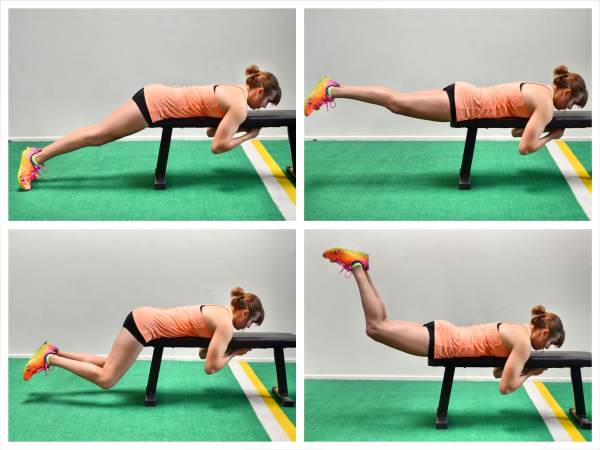
To do Bent-Knee Reverse Hypers, (shown in the bottom two photos), lie face down on a bench, box or table with your hips right on the edge of the bench. Hold on to the bench or something in front of you, but make sure it doesn’t make you stretch or tense up your neck and shoulders.
Make sure your hips are right about at the edge of the bench. If your hips are too far on the bench, you are more likely to hyperextend your low back in an attempt to get your hips up higher. However, having your hips too far off the bench, will also force you to have to lift more bodyweight and could cause you to engage and use your low back to lift.
Keep your legs close together or even place your heels together and turn your toes out to help you engage your glutes. Bend your knees to almost 90 degrees and flex your feet.
Then, with your knees bent, kick your heels up toward the ceiling, squeezing your glutes as you press your hips down into the bench. You can slightly drive up and out as you lift to really get your glutes to work.
Make sure that you squeeze your glutes as you lift and don’t hyperextend your low back just to get up higher. You also want to make sure to drive your hips and pubic bone down into the bench as you lift to make sure you are extending your hips and using your glutes.
Lift so that your quads are about parallel to the ground and lower back down. Only lift higher if you don’t feel your lower back taking over. The range of motion isn’t as important as simply getting your glutes engaged and working.
Consciously squeeze your glutes at the top and then lower down. You can even slow down the tempo of this move and add in a longer pause at the top to make your glutes work harder.
To do a Straight-Leg Reverse Hyper (shown in the top photos), you will set up with your hips on the edge of a bench just like you did with the Bent-Knee Variation. However, instead of bending your knees, you will keep your legs out straight.
Start with your feet touching the ground and your legs close together. You can place your heels together and turn your toes out if you struggle to get your glutes to engage and work during the movement.
Then, keeping your legs straight, drive your hips down into the bench as you lift your heels up toward the ceiling. Squeeze your glutes as you lift and extend your hips. Lift till your legs are about parallel to the ground and then lower back down. Only lift higher if you don’t feel your lower back taking over.
You want to focus on your glutes working to lift not your low back. If you do feel your low back, make sure you are pressing your pelvic down into the bench as you squeeze your glutes to lift. Make sure that you are also consciously engaging and contracting your glutes at the top of the lift.
Hold at the top then lower back down and repeat. Pause longer at the top to make the move more challenging.
Airborne Lunges – Often to make moves more challenging, we add weight. But another way to make moves more challenging is to make them unilateral movements where only one side has to carry our entire bodyweight.
Also, unilateral movements force each side to work independently, which can help us correct imbalances to prevent injury.
That is why exercises like the Airborne Lunge are so important to include. Not only are they super challenging exercises, but they can also help us correct imbalances and prevent injury.
The Airborne Lunge is also a great move to improve your core strength, balance and even your mobility while being a hip hinge movement that will work and strengthen your glutes.
And unlike many of the other Bodyweight Glute Exercises, which are more isolated movements, this move forces your glutes to engage during a compound exercise.
Since the Airborne Lunge is such a challenging movement that requires not only glute and core strength, but also a decent amount of balance and mobility, beginners may need to start by holding either a pole or Suspension Trainer to work through a full range of motion.
For a modified variation of the Airborne Lunge using a Suspension Trainer, check out the Single Leg Lunge.
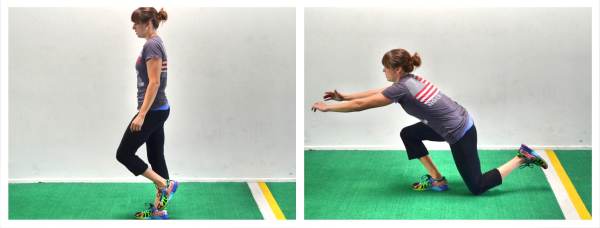
To do the full Airborne Lunge, start standing on one foot with the other knee bent so that your foot is lifted up behind you. As you sink into the lunge, you don’t want the lifted foot to touch the ground so make sure to bring that foot up toward your glute.
Then bend your standing leg and sit your butt back as you lunge down, dropping your back knee to the ground. As you sit back and lunge down, hinge forward slightly at the hips so you can really load your glute and sit back, but do not let your back round forward. Do not touch the back foot down when you drop the knee to the ground.
As you sit back and sink down, make sure you don’t try to reach the back knee too far back. Keep it just a little behind your standing foot. If you try to reach too far back, you won’t be able to touch all the way down and come back up to standing.
Once you’ve touched your back knee down, drive back up to standing, pushing through your standing heel to engage and use your glute. Make sure you don’t rock forward onto the ball of your foot as you drive back up.
Stand up nice and tall and squeeze your glute and then repeat the lunge.
Complete all reps on one side before switching. Make sure you engage your core and keep your standing heel on the ground at all times. Also, make sure you feel this move in the glute of your standing leg.
Step Down – Step Ups are a popular glute and leg exercise, but they may not be the best Step Exercise if you truly want to isolate and work each leg and really target your glutes.
When you do Step Ups, it is easy to push off the other leg to help you step up onto the box. It can also be easy to load your quads instead of using your glutes to drive up.
That is why the Step Down is such a great exercise to include. The Step Down is a great hip hinge movement to work the glutes that will also improve your balance. And because you start on top of the box, you can’t push off your other foot, which forces you to really isolate and work each side independently.
It can also be a great move to improve your mobility and stability as well as strengthen your body through an increased range of motion because you can constantly use a higher box to sink down lower on. (Remember, we maintain and even improve our mobility and flexibility by strengthening through a full range of motion. If we stretch but then don’t strengthen through the full range of motion we’ve developed, we will only tighten back up!)
Plus the Step Down is a great compound exercise that forces your glutes to engage and work while other muscles are also recruited.
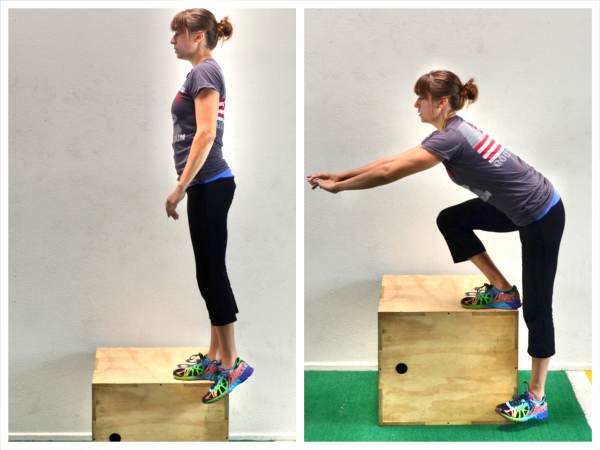
To do the Step Down, start standing on a bench or box. Stand close to the edge so that you can step off of it to the side with one foot. The higher the box you use, the bigger the range of motion you can do. You can also decrease the range of motion if you aren’t yet strong enough by using a lower box or by not sinking all the way down. You do not want to go too low and end up setting your foot down on the ground so that you can push off.
Standing near the edge of the bench with your other foot right on the side or hanging off, slowly hinge forward sitting your butt back as you drop the foot on the side down toward the ground. Keeping your back flat, push your butt back as you bend your standing knee to drop your foot toward the ground.
If you can, lightly touch the toe of the foot to the ground, but make sure you do not drop it all the way down so that you can push off of it. Sink as low as you can then drive right back up to standing. Make sure you are only driving through your standing heel and not using your left foot on the ground.
Do not rock forward as you come back up to standing. Really use your glute and drive through your heel. Stand back up nice and tall and squeeze your glute at the top.
Then repeat, sinking back down.
Go as low as you can and complete all reps on one side before switching.
Skater Hops – Building strong, powerful glutes also means including some jumping or sprinting exercises in your workout routine. If you can’t go outside and run stairs or sprint up hills, you can get in a great glute workout to develop powerful butt cheeks using Skater Hops.
Skater Hops are a great exercise to work your glutes while also improving your ability to laterally stabilize. They will improve your balance and core strength while also getting the blood pumping and legs burning.
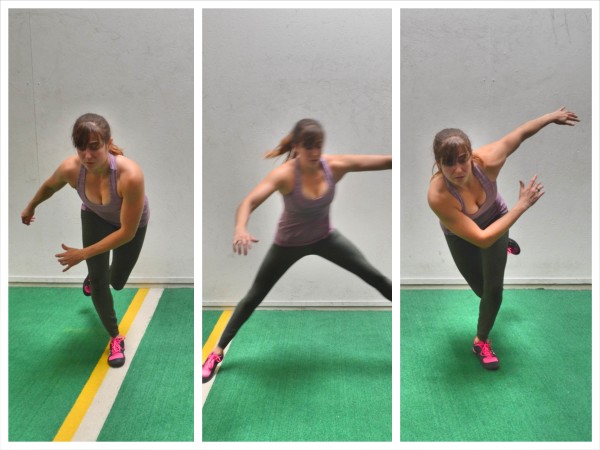
To do Skater Hops, make sure you have enough space to hop side to side. To set up, start standing to one side of the space you have to use.
If you start to the right side of the space, you will start standing on your right leg. Shift your weight so that you are standing on your right foot as you sink down into a little squat and swing your arms down in front of you and out to the right.
As you sink and swing your arms out to the right, you will load your glute so that you can then explode up off the right leg and jump toward the left and land on your left leg. Keep your chest facing straight ahead as you jump and land. Swing your arms slightly up and across your body to help you power the jump.
As you land on your left leg, sink right back into a squat, pushing your butt back so that you load your glute to help you jump back to the right. Your arms should also swing out to the left to help you not only balance, but also power the jump back.
Then push off your left leg and jump back right, landing on your right foot and sinking back into the slight squat. Try not to touch the other foot down when you land. Only touch the other foot down if you need to for balance.
Beginners may need to go slower and not jump as far to each side. It is important that you also work on your balance and don’t simply rush through the movement if you can’t stabilize on each side.
If you can balance, try to move as quickly as possible and cover as much ground as possible to really make your legs work.
Single Leg Deadlift Hops – Single Leg Deadlift Hops are another great glute powered jumping exercise; however, they are an incredibly tough move because they require a lot of balance.
They are though a great unilateral exercise that will help improve your balance and core strength as well as your glute power and hip stability.
While beginners may need to stick with a Single Leg Deadlift that doesn’t include the hop, if you have enough core strength and balance, you can do this hip hinge movement with a little hop at the top.
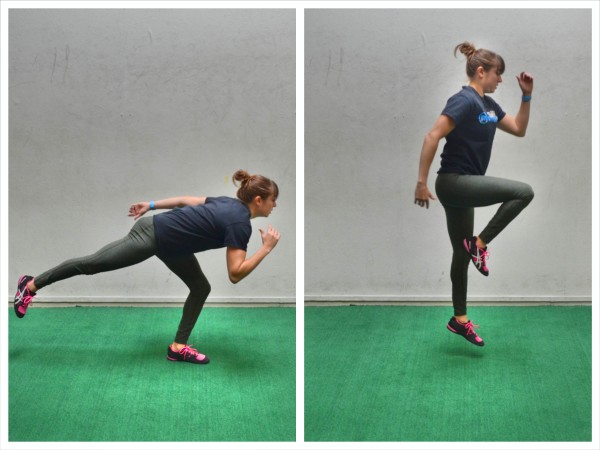
To do the Single Leg Deadlift Hop, stand on one foot with the toe of your other foot just lightly touching the ground.
Then hinge over on your standing leg, pushing your butt back as you lean forward and lift the other leg back toward the wall behind you. Keep your back flat and focus on loading your glutes as you swing the arm on the same side as your standing leg back and bring the opposite arm forward to help you balance.
Do not worry about keeping your standing leg straight. You should actually keep your standing knee soft although you do not want to actively bend it and squat down as you hinge over.
Hinge over in a controlled fashion then quickly drive back up to standing, exploding up off the ground as you come back up.
As you hop up off the ground and come up nice and tall, bring the back knee up and forward. As you raise the back knee up and forward, you will swing your arms so that your other arm goes back as your back arm comes forward. You want your opposite knee and arm to be forward.
Using your arms can help propel you up higher and also help you balance.
Land back on the same standing leg and hinge right back over before jumping back up.
You do not have to jump super high for this move to be very challenging. While you want to explode up as high as you can, you also want to focus on landing only on one leg and maintaining your balance throughout the reps.
When you land, make sure to slightly bend the knee and keep it soft. Complete all reps on one side before switching.



